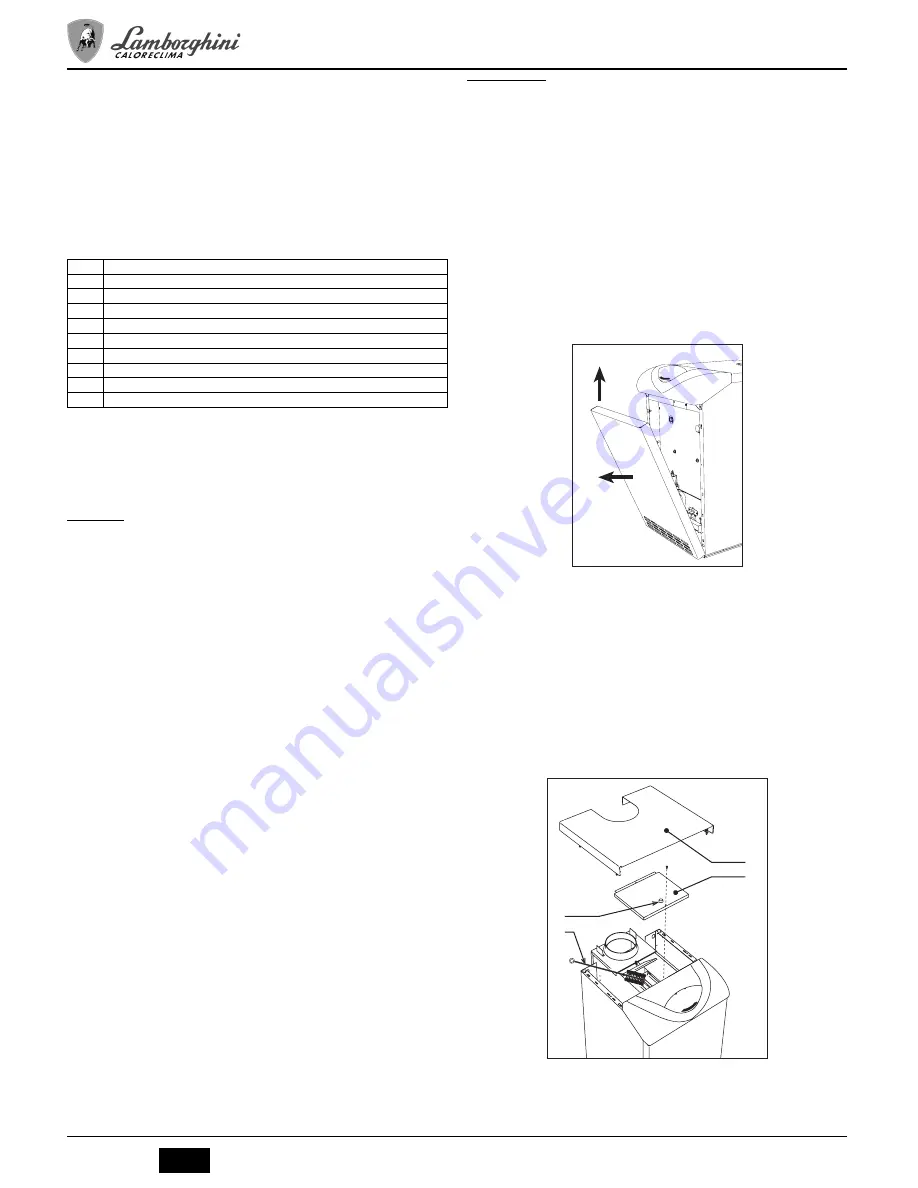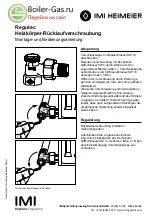
ERA MD
16
EN
cod. 3540Z410 - 03/2011 (Rev.00)
"Hi" - History Menu
The microprocessor can memorise the total hours with card fed (Ht) and the last 10 faults
(with detail of the time they occurred referring to parameter Ht).
The History datum item H1 represents the most recent fault that occurred, whereas the
History datum item H10 represents the least recent. The codes of the faults saved are
also displayed in the corresponding menu of the Opentherm remote temperature control
Note for calculation of hours:
•
Every 24 hours, the number shown in the part of the display normally reserved for
system pressure is increased by one unit.
•
Every hour, the number shown in the part of the display normally reserved for room
temperature is increased by one unit.
Press the Heating buttons to scroll the list of faults.
Press the Reset button to return to the Service Menu. Press the Reset button for 10 sec-
onds to exit to the card Service Menu.
"rE" - History Reset
Press the Eco/comfort button for 3 seconds to delete all the faults and times stored in the
History Menu: the card will automatically exit the Service Menu, in order to confirm the
operation.
Press the Reset button to return to the Service Menu.
4.2 Start-up
B
System start-up must be carried out by Qualified Personnel. Checks to be
made at first lighting and after all maintenance operations that involved discon-
necting from the systems or work on safety devices or parts of the boiler:
Before lighting the boiler
•
Open any shutoff valves between the boiler and systems.
•
Check the tightness of the gas system, proceeding with caution and using a soapy
water to detect any leaks in connections.
•
Fill the water system and make sure all air contained in the boiler and system has
been vented by opening the air vent valve on the boiler and any vent valves in the
system.
•
Make sure there are no water leaks in the system, hot water circuits, connections or boiler.
•
Check the correct connection of the electrical system.
•
Make sure the unit is connected to a good earthing system.
•
Make sure there are no flammable liquids or materials in the immediate vicinity of
the boiler.
•
Vent the air from the gas pipes by means of the gas valve pressure point (ref.
A
- fig. 20).
Lighting
Open the fuel on-off valves.
Connect the power to the unit.
For the next 120 seconds the display will show FH which identifies the heating system
air venting cycle.
During the first 5 seconds the display will also show the card software release.
When the message FH disappears, the boiler is ready to operate automatically whenever
domestic hot water is drawn or in case of a room thermostat demand.
A
If, after correctly carrying out the lighting procedures, the burners do not light
and the message A01 appears on the display, wait about 15 seconds and then
press the RESET pushbutton. The reset controller will repeat the lighting cycle.
If the burners do not light after several of attempts, consult the "Troubleshoot-
ing" section.
A
In case of a power failure while the boiler is working, the burners will go out and
relight automatically when the power is restored.
Checks during operation
•
Make sure the fuel circuit and water systems are tight.
•
Check the efficiency of the flue and fume ducts while the boiler is working.
•
Make sure the water is circulating properly between the boiler and the systems.
•
Check correct lighting of the boiler, by turning it on and off several times.
•
Make sure the fuel consumption indicated on the meter matches that given in the
technical data table on cap. 5.3.
•
Check the correct delivery of domestic hot water with the
'
t given in the technical
data table: do not trust measurements made with empirical systems. The measure-
ment should be made with specific instruments and as close as possible to the boil-
er, also considering the heat loss from the pipes.
4.3 Maintenance
B
The following operations must only be carried out by Qualified Personnel.
Seasonal inspection of the boiler and flue
It is advisable to have the following checks carried out at least once a year:
•
The control and safety devices (gas valve, thermostats, etc.) must function correctly.
•
The fume ducts must be clean and free of obstructions.
•
The gas and water systems must be tight.
•
The burner and exchanger must be clean. Follow the instructions in the next section.
•
The electrodes must be free of scale and properly positioned (see fig. 24).
•
The water pressure in the system when cold must be approx. 1 bar; otherwise bring
it to that value.
•
The expansion tank must be filled.
•
The gas flow and pressure must correspond to that given in the respective technical
data tables.
•
The circulating pumps must not be blocked.
Opening the front panel
To open the front panel, see the sequence in fig. 21.
B
Before carrying out any operation inside the boiler, disconnect the power supply
and close the gas cock upstream.
fig. 21 - Front panel opening
Cleaning the boiler and flue
To clean the boiler properly (fig. 22):
•
Turn off the gas ahead of the unit and disconnect the power supply.
•
Remove the boiler front panel.
•
Lift the casing cover by pressing upwards.
•
Remove the insulation placed over the anti-backflow device.
•
Remove the smoke chamber closing plate.
•
Remove the burner assembly (see previous par.).
•
Clean from the top downwards, using a flue brush.
•
Clean the fume evacuation ducts between the cast iron elements of the boiler shell
with a vacuum cleaner.
•
Carefully reassemble all the previously disassembled parts and check the tightness
of the gas circuit and the combustion ducts.
•
During cleaning operations be careful not to damage the fume thermostat bulb fitted
in the back of the smoke chamber.
fig. 22 - Boiler cleaning
1
Casing cover
2
Smoke chamber closing plate
3
Flue brush
7
Combustion analysis plug
Ht
Total hours with card fed.
H1
Fault code --> Time when the fault occurred (referring to Ht)
H2
Fault code --> Time when the fault occurred (referring to Ht)
H3
Fault code --> Time when the fault occurred (referring to Ht)
H4
Fault code --> Time when the fault occurred (referring to Ht)
H5
Fault code --> Time when the fault occurred (referring to Ht)
H6
Fault code --> Time when the fault occurred (referring to Ht)
H7
Fault code --> Time when the fault occurred (referring to Ht)
H8
Fault code --> Time when the fault occurred (referring to Ht)
H9
Fault code --> Time when the fault occurred (referring to Ht)
1
2
1
2
7
3
















































